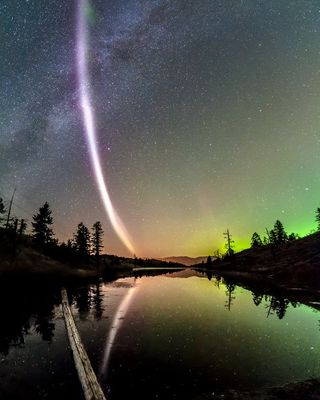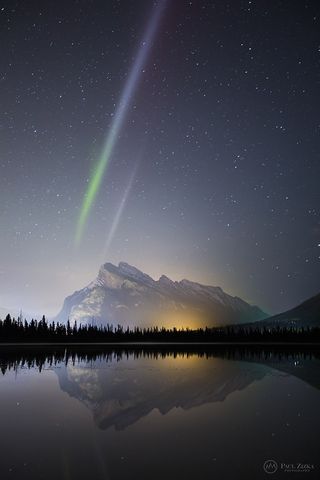An Aurora Called 'Steve'? Strange Sky Phenomenon Investigated
Meet "Steve," a strange, new aurora feature discovered by citizen scientists and verified by the European Space Agency's (ESA) Swarm satellites.
Eric Donovan, a researcher at University of Calgary in Canada, first heard of "Steve" while talking to members of a Facebook group called the Alberta Aurora Chasers, who coordinate to track and photograph the northern lights in the Canadian sky (Alberta is a province in western Canada). While the colorful lights of an aurora normally ripple horizontally across the sky, Steve formed a distinctive purplish or greenish vertical streak.
To learn more about it, Donovan coordinated with the Facebook group to match sightings of the feature with data from the Swarm satellites, which measure Earth's magnetic field, and ground-based scientific cameras that monitor the sky. [Paragliding Through Aurora Borealis' Beauty (Video)]

"In 1997, we had just one all-sky imager in North America to observe the aurora borealis from the ground," Donovan said in an ESA statement. "Back then, we would be lucky if we got one photograph a night of the aurora taken from the ground that coincides with an observation from a satellite. Now, we have many more all-sky imagers and satellite missions like Swarm, so we get more than 100 [observations] a night."
Auroras are generated when charged particles ejected from the sun are drawn to Earth's north and south poles by the planet's magnetic field. There, they hit neutral particles in the upper atmosphere and let off splashes of color and light in the sky.

For some time, photographers had referred to features like Steve as "proton arcs," according to a 2016 article on Spaceweather.com (and a corresponding photo gallery), coming from protons hitting the atmosphere rather than the ordinary auroras' electrons. Vanexus Photography also shared a spectacular video of that feature forming in Porteau Cove Provincial Park near Vancouver, Canada in 2016 (the feature now called Steve appears at the beginning and end of the video).
In fact, protons hitting the atmosphere produce only diffuse visible light (as researchers discussed in the Spaceweather.com article), so Donovan said he knew the phenomenon must have another cause and insisted on a new name. The aurora photographers chose to go with "Steve," Donovan said in a recent talk at a Swarm science meeting in Canada.
Get the Space.com Newsletter
Breaking space news, the latest updates on rocket launches, skywatching events and more!
Within a few weeks of searching, Donovan identified signs in the ground-based data that could match a Steve-like feature, and asked the Facebook group whether anyone had spotted it — sure enough, there were photos of Steve from that very location. And better yet, one of the Swarm satellites had flown through the feature.
"As the satellite flew straight through Steve, data from the electric field instrument showed very clear changes," Donovan said in the statement. "The temperature 300 kilometers [200 miles] above Earth's surface jumped by 3,000 degrees Celsius [5,500 degrees Fahrenheit], and the data revealed a 25-km-wide [16 miles] ribbon of gas flowing westwards at about 6 km/s [3.5 miles per second] compared to a speed of about 10 m/s [33 feet/s] either side of the ribbon."
The phenomenon called Steve had never been captured with those scientific tools before, even though it is "remarkably common," Donovan added. "It's thanks to ground-based observations, satellites, today's explosion of access to data and an army of citizen scientists joining forces to document it."
And going forward, data from Swarm and other scientific tools can begin to narrow down where this kind of aurora comes from. Crowdsourcing tools like Aurorasaurus use Twitter and submitted observations to track the aurora's appearance, and social networks of photographers, like Alberta Aurora Chasers, provide additional data that's crucial to tracking these features down more precisely than ever, Donovan said.
In the talk, Donovan concluded by pointing out that in 1997, scientists couldn't have pinpointed the newfound phenomenon at all. Fifteen years ago, it would have cost $200 or $300 million to track down something like Steve over the course of 10 years, he said. Now, with the help of citizen scientists and all the infrastructure that's available for observation, it was possible to close the loop in a matter of weeks, Donovan said.
"We really are in a truly new era," he added.
Email Sarah Lewin at slewin@space.com or follow her @SarahExplains. Follow us @Spacedotcom, Facebook and Google+. Original article on Space.com.
Join our Space Forums to keep talking space on the latest missions, night sky and more! And if you have a news tip, correction or comment, let us know at: community@space.com.

Sarah Lewin started writing for Space.com in June of 2015 as a Staff Writer and became Associate Editor in 2019 . Her work has been featured by Scientific American, IEEE Spectrum, Quanta Magazine, Wired, The Scientist, Science Friday and WGBH's Inside NOVA. Sarah has an MA from NYU's Science, Health and Environmental Reporting Program and an AB in mathematics from Brown University. When not writing, reading or thinking about space, Sarah enjoys musical theatre and mathematical papercraft. She is currently Assistant News Editor at Scientific American. You can follow her on Twitter @SarahExplains.